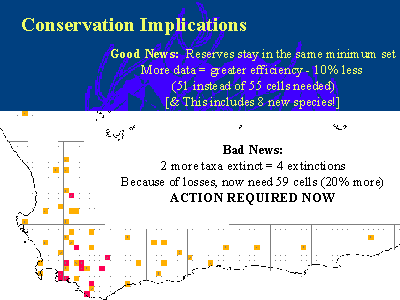 CONSERVATION
IMPLICATIONS OF THE ATLAS DATA
What do these results mean?
Are they of any practical use?
Have we achieved anything concrete?
One way is to see what these results mean to conservation planning. We have some
conservation planning tools into which one can feed the Protea Atlas Project data. (You
can play on Worldmap too, and run the simulations discussed
below).
What interests us is the conservation implications BEFORE and AFTER the Protea Atlas
Project!
If we determine the optimum configuration of nature reserves to conserve every protea
at least in one reserve we find the following:
The minimum set has not changed Efficiency has increased Action is required - we are loosing our jewels
Enough bad news - are you sure that you want more? |

![]()
